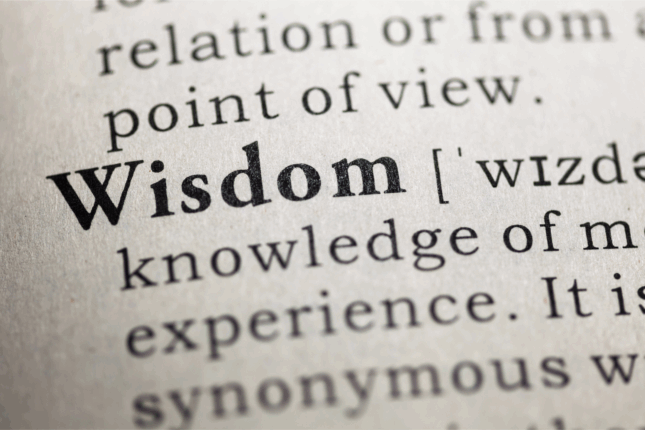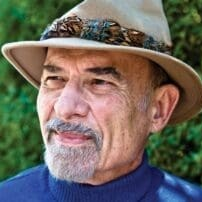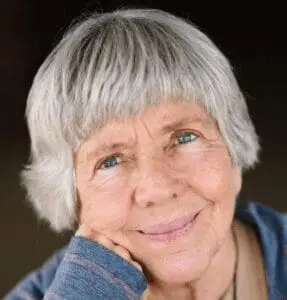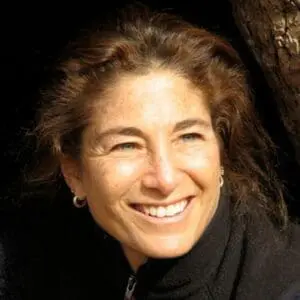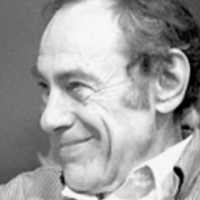It’s hard to escape the creeping sense that despite what we know or think we know, we’ve never been less wise.
So much about our society seems to be the antithesis of wisdom. So many of the rich and powerful may be smart, but not wise; too often they appear to be barely disguised charlatans, hucksters, scoundrels, fools, or all of the above. Even the idea of wisdom seems to have suffered from a kind of brand degradation: how meaningful can the term be when it’s relegated to glib one-liners in animated movies like Mufasa in The Lion King, Yoda in Star Wars, or Gandalf in The Hobbit? There’s even a book, by an Oxford University research psychologist no less, called The Wisdom of Psychopaths: What Saints, Spies, and Serial Killers Can Teach Us about Success. Wisdom, how far hath thou fallen!
Nevertheless, genuine wisdom and wise people, however few and far between, are still around. If not, the human race would have self-destructed long ago. But how do we know it when we see it? Is it innate—a genetic gift, like perfect pitch? Do you get it in a sudden burst of enlightenment? Or is it a predilection of mind that you buff and polish until it glows? One dictionary definition of this notoriously slippery term is itself almost as slippery: “the ability to discern or judge what is true, right, or lasting; insight.” And that ability would demonstrate itself . . . how?
What follows are excerpts from conversations with people we think are the wisest souls in the world of psychology and psychotherapy, who came together for a series of interviews called “6 Faces of Wisdom.”
Living the Unlived Life
By Tara Brach
One of the things that distinguishes therapy from a purely spiritual path is the engagement with one’s personal story. The therapist collaborates with the client to look at the personal patterns that play out in daily life and discover what might help in coping more effectively and finding more ease and happiness. On the spiritual path, suffering arises from any identification as a separate self. The key inquiry on the spiritual path is how is this identification being fueled and what awakens us to our wholeness. In other words, therapy’s main concern is the story of the personal self. Spirituality includes that story, but emphasizes who we are beyond the limiting notion of self.
In Western psychotherapy, sharing one’s personal story creates rapport and intimacy and serves as a portal to discovering where experience lives in the body and in the heart, but many people can get fixated on the story and never go beyond it. So that’s the shadow side of psychotherapy. The shadow side to what’s called spiritual practice is sometimes a dismissal of the story and the poignant constellation of feelings and emotions that surround it. So I think it’s important to find a middle way, where you honor the story, but don’t get lost in it. The Tibetan teacher Tsoknyi Rinpoche talks about our beliefs, stories, and emotions as “being real, but not true.”
That means we need to acknowledge that our beliefs feel real in our bodies and hearts, but don’t actually translate into the truth of reality itself—just like our thought of an apple isn’t the same as biting into and tasting it. If we can recognize that, everything starts opening up. We can honor the portal, but we keep reentering the real, living, dynamic reality that’s here.
The Power of Intentionality
When clients come to me for help, right from the start, I want to hear about what their deepest intention is. I invite them to go to the most sincere place in them and say what it is they’re really wanting. That lets me know how large a view they have of what’s possible, and it helps me say, “OK, this is where you are right now. Let’s take the first step.”
The first thing I’m doing is in some way asking, “What’s your hope? What’s your aspiration?” When we aren’t aligned with our deep aspiration, we suffer. There’s a question you can use to get at this that’s pretty straightforward: “What’s asking for attention in your life right now?” Suffering is a way of calling attention to a certain part of us that needs attention.
My assumption is that something in them is longing for what I call refuge, or for really coming home to a place of inner peace and a loving heart. I think that we’re all longing for that. I sometimes think of William James, who said “All religions begin with the cry for help.” We all sense the uncertainty of this existence, so everyone of us on some level is looking for what will allow us to feel more at home in our own being. Becoming conscious of our longing for refuge—for peace, for freedom—is an essential part of what energizes our path.
Opening to the Larger Self
There’s a wonderful teaching from Carl Jung that says that whatever within us that is unlived controls us. When we’re traumatized, we’ve got unlived fear in our body that needs to play itself out, and unlived grief that needs to be grieved. When we live the unlived life, that very process opens us to a larger sense of wholeness. The process of emotional and spiritual healing is one of living the unlived life.
Viktor Frankl wrote that between the stimulus and the response there’s a space, and in that space is our power and our freedom. When there’s unlived life, we’re caught in a chain reaction that keeps us from contacting what might feel raw or intense. By pausing and becoming present, we can tap the inner resources that give us our power and our freedom. We’re able to open to the unlived life and integrate this vital energy into the larger whole of our being.
Self-Compassion
The practice of self-compassion trains us to let ourselves be touched by the suffering in our own bodies and hearts, and actively offer care. In this culture, that’s radical, because we‘re taught to pride ourselves on being rough and tough on ourselves, always trying to be in a self-improvement project. I often use the gesture of the hand on the heart because it deconditions that inner armoring and helps us discover this vast feeling of tenderness that can offer care inwardly.
Our survival-oriented brain makes it hard for us to stay with the places that are difficult inside us. We don’t want to be with unpleasantness. But there’s a very wise spiritual equation: Pain x Resistance = Suffering. We perpetuate our suffering because we have all sorts of clever strategies to resist emotional pain. Whether we busy ourselves or distract ourselves or judge ourselves, we just keep away from that pain. So the practice of self-compassion means training ourselves to quiet our minds, stay with our experience, and remind ourselves to come into the body and heart.
Transcending the Habitual
By Eugene Gendlin
The starting point for much of my work is the recognition that the body isn’t what we always thought the body was: a thing, a mechanical object, like an automobile that we drive or manipulate. A simple but powerful way to shift your experience of life is to take your attention and deliberately put it on your body.
At first, you may not get anything, but if you just stay there for about 30 seconds or a minute—or if you keep coming back there—pretty soon you develop what I like to call a “felt sense.” That’s a body sense of the whole situation: not just one feeling, not just that you’re angry or happy, but the whole Gestalt of what’s going on for you at that moment.
It’s comforting to be in touch with a felt sense. It’s like now you know in some immediate way that our experience of life is always an interaction of both the body and the environment. That doesn’t mean only interaction with another person. It’s how you’re sitting, what you’re inhaling, and the whole situation surrounding you. It’s the past; it’s what led up to this present moment. Most of us are still stuck in one spot or another in the past, and all of that’s in the body.
Focusing vs. Mindfulness
Mindfulness, at least as I see it being practiced by many people today, is like sitting at the head of the stairs and looking out at everything that comes up the stairs and saying “Oh, I see anger. Oh, I see impatience. Oh, I see this. Oh, I see that.” But I say, “Go downstairs. Don’t just sit there and be the passive observer. Go downstairs and see where everything is coming from.”
For their part, the mindfulness people say, “Make sure that you regularly go back upstairs so that you don’t get caught by every different emotion and every different feeling.” To which, I’d say, “Yes, but the focus needs to be downstairs, in the body.”
It’s also important not to consider the body as being somehow opposed to the conceptual, cognitive ability we have as human beings. To me, it’s a dialogue: the conceptual gives us an understanding in the body that’s important, and the felt experience of our body leads us further than we’re able to go just with what we can put into language or from our concepts about the world. So analyzing is important, but it needs to be in dialogue with the rest of our experience.
Wonder
The body has a natural tendency to say, “What’s next?” and to go forward. So when you’re working with someone in therapy who’s experienced something horrible, there’s always a part of the person that wants to move forward. It’s like when the picture is hanging crooked on the wall and something in your body tells you to get up and straighten it.
In this life, we regularly discover that there’s all this crap—the difficult experiences we try to avoid—but there’s also magnificence that we can sense. In animals, in trees, and in the rocks, there’s a magnificence that’s obviously there, and you can find it if you look out the window. But sometimes it seems far away over there, and it often comes mixed up together with the horror. That’s one of the biggest things to learn in life. The wonder of the whole thing is so much bigger than anyone can see. At this stage in my life, it’s more important to me to take it all in and not get distracted by trying to invent too many fancy phrases to describe it.
Acting Wisely
by Mary Pipher
My turning point in thinking about the environment was reading Bill McKibben’s Eaarth. Basically, what he says is very simple: what we’ve previously thought of as Planet Earth no longer exists. The weather, the biological diversity, the oceans, the coral reefs, and the polar icecaps aren’t the same. Global climate change isn’t something that’s going to happen in our grandchildren’s lifetimes, it’s happening now, and it’s going to accelerate. We don’t have 50 years to wise up and save the planet; we have the next 10.
When I first read Eaarth, it just knocked me out. For a couple of days, that’s all I could think about. I wanted to forget what I’d read and go back to just eating shrimp cocktails and having fun and not worrying. Then I decided to face the reality that disastrous climate change might not be something we could avert. Even if we all do the best we can, who knows what might happen? But I determined that I wasn’t going to be miserable about this problem all the time.
So I decided to get to work, because action has always been what pulls me out of despair. I tend to be someone who, once I think I’ve done all I can, relaxes about things I know I can’t control. I decided to form a group in Lincoln, Nebraska, my home town, that we originally called 350.org Lincoln after McKibben’s international group. The figure 350 is the parts per million of CO2 that we need to have a sustainable planet. Now, sadly, it’s already way above that, so it’s not a question of sustaining that level; it’s a question of coming back down. But that’s why he chose that name: it’s an instant reminder of what we’re dealing with at the most basic level.
At our first meeting, I didn’t know anything about being an environmentalist or a good community organizer, but I had the sense to know that, whatever else happened, we needed to have a good time at these meetings so that we’d want to keep getting back together. So I bought some wine and cooked a really good dinner, and we started to talk.
If you can create a safe environment with people who are eager to help, even with people who don’t necessarily know what to do, commitment to make things better begins to pour out. We talked a lot about the idea of “distractionable intelligence” versus “actionable intelligence.” Distractionable intelligence is all this stuff out there that makes us real uneasy, like knowing that the coral reefs are dying or the albatross are dying on Midway Island because they’re eating plastic. Those kinds of facts can make us really sad, but don’t give us any idea what to do tomorrow.
Instead, the really important information that we wanted to get out in our community was what we called actionable intelligence: given this information, you know what to do when you leave the meeting. We decided everything would be action oriented, and that was a great help to all of us. Early on, our focus became stopping the XL Pipeline, which the oil companies wanted to build across our state. I decided I’d write a book about facing the challenge of climate change, because I’m a writer and therapist. I understand denial and resistance, and I know how to take a problem that’s utterly puzzling to me and help other people by sharing what I learn about it.
Our group started teaching local people that all you have to do to be a community organizer is invite two friends into your living room, serve tea, talk together, and make a plan. That’s what a community organizer is. It was fun to see people who’d never have described themselves as activists or community organizers start to learn how to engage and educate other people.
Moral Imagination
The biggest obstacle to doing anything about a climate change is getting past how traumatizing it is to think about it. By now, we all know that people shut down when they experience trauma. But there’s also a cycle that goes from trauma through awareness to resilient coping. Then, at a certain point, resilient coping can become what I call a transcendent response. To get to that kind of response, you need several elements. One is what Martin Luther King called the beloved community, a sense that people are working together with you in the service of a larger cause.
Another important shift is helping people grow their moral imagination. I define that as the ability to understand how the world looks from another living being’s point of view. Ecophilosopher and author Joanna Macy has a wonderful exercise called the Council of All Beings. In this exercise, people are appointed to represent the viewpoints of, for example, the hawk, the river, the rancher, and the fox. They sit around a table and discuss whether or not a certain situation should be allowed to occur or should be made to occur.
For me, the whole point of life is to grow my own moral imagination and help others cultivate theirs. That doesn’t mean every time I see a fly I develop a relationship with that fly, but it does mean that I see the fly as having a valid place in the universe. Of course, mostly we don’t enjoy flies being around us, but they have an important place in our ecosystem.
The idea of the “good” for me is easy to define: it’s what increases the moral imagination. “Bad” is what decreases the moral imagination. Much of psychotherapy is about moral imagination, which means helping people try to understand the point of view of the human beings they’re involved with.
Therapy and Social Activism
When it comes to climate change, it’s still hard to know exactly what to do as therapists without proselytizing to our clients; however, if a client brings up sadness about an environmental issue, it’s important to not just label that person depressed and suggest getting more exercise. We need to be ready to see that person’s response as a deep sadness, a grieving for the loss of our mother—our Mother Earth—which in some people induces a kind of primal panic. In fact, those kinds of thoughts and feelings contribute to a lot of the free-floating anxiety we see in the culture today.
So I think climate change can be discussed as a legitimate issue, as opposed to a foil covering up other “deeper” issues. I remember at one point, I started telling clients who came in and complained about poverty to take things to the next level. What action would you be willing to consider that would be of use to the world and also probably of use to you?
In fact, all my arguments about social action and activism are mental health arguments. I have no idea if our group will stop the XL Pipeline. What I do know is people are happier if they’re engaged in communities doing good work—if they’re acting on their despair, as opposed to just sort of stewing in it. I believe that therapists are likely to be most useful using their abilities to be educators and community organizers to move forward the dialogue about climate change.
The question for many of us is where to find the strength and inspiration to face the tough road ahead, if we hope to do something about climate change. For me, the most reliable way to get renewed is to experience bliss and awe. As I was working on my book, I remember one time when I was feeling extremely stressed, reading all this god-awful bad news about the environment. So one morning, instead of writing, I drove out alone to a little prairie about 20 miles from my home and lay down in the prairie grass. It happened to be in the spring, so the snow geese were flying over. I just looked up at the sky and listened to the wind and felt the dirt on my back. I probably stayed there half an hour, just listening, watching, and smelling the beautiful smell of prairie grain. And when I got up and went back to my car, it’s like my entire arousal system had tamped way down. I think all of us have had those moments when we realize that we’re very small, and we let ourselves feel grateful to be included in something so vast and wonderful.
Two Systems
By Daniel Kahneman
It’s generally recognized that there are two ways in which thoughts come to mind. If I say “two plus two,” something instantly comes to your mind. If I say “seventeen times twenty-four,” probably nothing comes to mind immediately. You can produce a solution if you know how to do it—it’s 408—but computing that’ll take you some time. Clearly, different operations are involved in the response to different kinds of problems. That’s what I call System 1 and System 2.
System 1 is associative and immediate. In System 1, things just come to our mind. System 2 is different. We feel that in System 2, we’re the authors of our own thought. System 2 requires attention, effort, and mental work.
In System 1, we’re more aware of feelings, wishes, or vague intentions. In System 2, we’re often aware of not doing everything that comes to mind, but System 2 mostly engages and endorses what comes to mind from System 1. I sometimes describe System 2 as the relationship between a newspaper editor and a journalist. The journalist (System 1) writes stories, while the editor (System 2) looks at them to see whether there’s a major problem; if not, it just goes to print. Only if there’s a problem do you slow down and try to do something that doesn’t immediately come to mind.
In psychotherapy, you’re often trying to get System 1 and System 2 to relate to each other in a somewhat different way. It may be that System 1 is running the show in someone’s life, and their System 2 is trying to talk back to System 1, but without a lot of success. Just as being aware that you’re addicted to something doesn’t enable you automatically to get out of that habit, System 1 is the associative machinery of our mental processes, and it’s typically very hard to change it. While you can teach System 2 new tricks to some extent, System 1 is difficult to reeducate.
Strategies of Change
Still, there are many ways in which System 2 can influence the operation of System 1. In the first place, you can make decisions about the context of your life, and then the context will take over. So if there are no cigarettes in your home, you’re less likely to smoke. If there are no cookies, you won’t eat cookies. The easiest form of self-control is to restrict your environment in a way that’ll reduce temptations.
I’m not an expert on therapy, but much of what therapists seem to do is help people re-image the situations in their life and acquire new mental habits. What can make that process difficult is that while System 1 is quick to change responses to context, it’s slow to learn new habits. Nevertheless, we do learn to drive and acquire other everyday skills in life and, to some limited extent, we can acquire different mental skills, or we can overcome some habits of mind that bring us misery. For example, it sometimes happens that people find new ways to label what’s happening to them, and that new label may have different emotions associated with it. So by labeling situations in a new way, you can sometimes change your response to them. So insights in therapy, to the extent that they lead you to a different labeling of situations, can change people’s emotional response. Actually, relabeling isn’t all that different from acquiring a new habit.
The Power of Story
Our associative memory is organized to maintain an ongoing narrative of our life. This happens automatically. We don’t have to deliberately construct stories: our associative machinery is built in such a way that it tends to produce interpretations of the world, stories that are more coherent and simpler than reality. If something happens, we tend to look for a possible cause and, without deliberate effort, typically link two events to make up a story to “explain” what happened. The halo effect, attributing positive qualities in one context to someone who’s impressed us in some other way in another context, is an example of a simple associative story. If somebody is good at something, we tend to see them as good in everything. Black and white is simpler than recognizing shades of gray.
Our tendency toward believing our own stories is important in determining how we think about our lives. If you ask somebody, “How was your vacation,” as opposed to asking in a given moment of the vacation “How are you now?” you’re asking different questions to different aspects of the self. The first question is addressed to what I call the “Remembering Self” and the second question is addressed to the “Experiencing Self.” In fact, the Remembering Self doesn’t necessarily take into account what the Experiencing Self has actually been through.
The Remembering Self tends to be sensitive to the structure of a story, especially how things end. If an experience ends well, then it casts a different coloring on what went before. So it turns out that we tend to control our life by anticipating how we’ll remember something in the future. It’s the Remembering Self that’s really in charge, and it drags the Experiencing Self along, frequently imposing experiences on the Experiencing Self that aren’t necessarily the best ones.
Here’s a thought experiment that highlights the difference I’m talking about. Think of your next vacation and then imagine that at the end of the vacation you’ll be given a drug that causes you to forget the whole vacation. Would you go to the same vacation, even if you knew you wouldn’t remember it? Would you go on vacation at all? Would you go on a different vacation? Thinking about that’ll give you the idea that there’s a lot that you do because you’re creating memories, and knowing that there are going to be no memories changes our attitude about what we’re doing.
What Really Matters
Wisdom, as I understand it, is an ability to look at complex situations and distinguish what’s important from what’s not important. It’s the wheat from the chaff. Wisdom is about determining the things that really matter and what’ll make a difference in the long run. Wisdom might be thought of as our ability to allow our System 1 and System 2 to have regular conversations with each other, to be aware of all the automatic errors we make in coming to our judgments because of the built-in biases of our cognitive machinery.
I’d like therapists to think about themselves and their own reactions in terms of System 1 and System 2. I’ve spent many years studying these systems, and, with all that, I still can’t say that I’ve been successful in changing many of my own bad mental habits. The best we can often do is to just be aware of how unreliable our mental machinery can be.
Cultivating Authenticity
By Irvin Yalom
I entered psychiatry as many people did in the 1950s, seeing a traditional, Freudian psychoanalyst four times a week. She was older and had a suite of five offices, all of them rented by therapists she’d once analyzed. She was like a grandmother analyst, and I guess you could say I spent 700 hours being psychoanalyzed by my grandmother.
Looking back, it’s clear it wasn’t 700 hours well spent. In fact, it offered a good instruction on how not to do psychotherapy. Despite all the time and expense, we never dealt with any of the issues that came to seem to me more and more the central concerns of life in later years: mortality, freedom, the search for meaning, and our ultimate existential isolation.
Then in 1958, psychologist Rollo May came out with his book Existence and, suddenly, I saw there was a third way for psychotherapy—something that wasn’t biological or psychoanalytic, but a way of grappling with the great existential challenges of life. I decided to write a textbook to further explore this new, alternative pathway for therapists. To do that, I felt I needed to do something bold that nobody else was doing at that time: I needed to talk to people facing their own mortality close up.
My ordinary patients weren’t prepared to do that, so I asked the other professors at Stanford and the faculty in the medical department to send me their dying patients so I could talk with them. By then, I had quite a bit of group experience, so I started seeing these patients in groups.
That experience was extremely anxiety provoking, for me and my students. It was so poignant and moving to listen to people trying to cope with the idea that they were going to die shortly that I actually developed night terrors, and many of my students watching these group sessions from behind a one-way mirror often ran out of the room in tears.
Psychotherapy’s Biggest Challenge
The thing that’s most troubling to me about our field is the demise of training in the kind of psychotherapy that I’m familiar with. These days, I feel that I’m a bit of a dinosaur. I’m in a group of 11 other therapists, a bunch of white-haired therapists, all with full practices who have more patients than we can see. But there aren’t going to be people like us in the future. If somebody wants a referral to a good psychotherapist now, I’ve got to really strain to find one. I find myself thinking, “They’ve got to see someone with gray hair, because the young psychiatrists aren’t being trained to do depth psychotherapy—or really any kind of psychotherapy.” Cognitive-behavioral therapy has taken over.
Recently, I met with a bunch of group therapists who each led, on the average, five or six groups. That meant there are about 80 therapy groups represented in our little seminar, almost all of them short-term, behaviorally oriented. The emphasis was on imparting knowledge, teaching people about subjects like panic attacks or other anxiety symptoms, giving them exercises to work on, and doing manualized treatment. None of them was interested in helping people focus on how they came across interpersonally or how to solve other interpersonal issues. That’s sad to me.
Being 82
I’m a little bit mellower about facing my own mortality at this point. I don’t have the uprising terror and anxiety that I used to feel. The other day, somebody sent me a picture of the Stanford faculty in 1963. It was wonderful seeing all my old friends. I thought, “Oh, I’ll e-mail this to some other people.” Then I realized that almost everybody else in the photo was dead. That was a sad moment for me.
At this stage of my life, I’m finding that once you get your mind around the idea that death isn’t so far off, you can actually learn to live a little bit differently. My wife, Marilyn, is slightly younger—a half-year younger than I—and we’re enjoying our times together very much. Recently it’s been warm weather, and Marilyn doesn’t want to do anything but sit outside in the sun and read the newspapers with me. It feels so good. We keep making jokes saying, “I guess these are the Golden Years,” and they really are.
I learned a long time ago from my group of cancer patients that there are many people, even in the midst of this awful illness, who actually start to change in a positive way. They grasp that they’re going to die and begin to say, “Why am I spending time doing what I don’t want to do? Why am I seeing people I don’t want to see?” They begin to reexamine what’s really meaningful and what’s trivial in their lives; they start saying no to things they don’t want to do.
Once you fully realize that you really are mortal and that you’re going to die, you can come to appreciate life more fully. You don’t waste quite so much time striving for material goods. As German philosopher Arthur Schopenhauer said, if you strive for objects all the time, eventually, you don’t have them: they have you.
Irvin Yalom
Irvin D. Yalom, MD, is one of the world’s foremost psychiatrists, a visionary therapist and internationally bestselling author who has helped define the fields of group psychotherapy and existential therapy. His textbooks Theory and Practice of Group Psychotherapy and Existential Therapy remain standards for therapists in training worldwide, as does The Gift of Therapy: An Open Letter to a New Generation of Therapists and Their Patients. He’s also the author of the New York Times best-sellers Love’s Executioner, Momma and the Meaning of Life, Creatures of a Day, and Staring at the Sun: Overcoming the Terror of Death. A consummate storyteller, his teaching novels based in philosophical inquiry and psychological insight, including When Nietzsche Wept, The Schopenhauer Cure, Lying on the Couch, and The Spinoza Problem, have been best sellers in multiple countries. More at www.yalom.com
Mary Pipher
Mary Pipher, PhD, is a clinical psychologist, author, and climate activist. She’s a contributing writer for The New York Times and the author of 12 books, including Reviving Ophelia, Women Rowing North, and her latest, A Life in Light. Four of her books have been New York Times bestsellers. She’s received two American Psychological Association Presidential Citation awards, one of which she returned to protest psychologists’ involvement in enhanced interrogations at Guantanamo.
Tara Brach
Tara Brach, PhD, is a clinical psychologist, an internationally known teacher of mindfulness meditation, and the founder of the Insight Meditation Community of Washington. She is author of bestselling Radical Acceptance and True Refuge, and leads accredited workshops for mental health professionals interested in integrating meditation into the practice of psychotherapy. Tara offers meditation retreats at centers in the United States and in Europe. Her podcasted talks and meditations are downloaded about a million times each month. In addition to her public teaching, Tara is active in bringing meditation into DC area schools, prisons and to underserved populations, and in activities that promote racial justice.
Eugene Gendlin
Eugene Gendlin is best known as a pioneer in the development of mind-body approaches to therapy. He’s the developer of Focusing, an experiential form of psychotherapy that encourages clients to get in touch with a “felt sense” of their bodies.
Daniel Kahneman
Daniel Kahneman, a cognitive research psychologist, received a 2002 Nobel Prize in Economic Sciences for his work demonstrating that human beings tend to make decisions on the basis of fast, spontaneous, intuitive—often wrong!—reactions and subjective experiences, rather than objective facts, slow deliberation, and hard logic. His book “Thinking Fast and Slow” explores the role of the automatic response in human thought, and just how instinctively unwise we can be.

